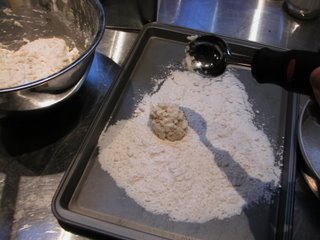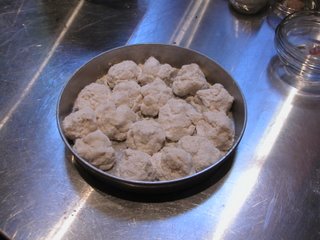Molten Baked Alaska


WARNING: This is probably some of my worst writing ever. Its a cobbling of disparate recipes, over months, on 6 different computers.
Dale brought up a good point the other day as I proposed a cake for Tom's birthday. He said that everyone should know the favorite birthday cake of a significant other. (His tone of voice told me to take this seriously.) You can't just make something because you want to; it has to be the person's favorite. Since I haven't been asked what my favorite birthday cake is for years, I had to stop and consider this. True, Auntie H always made me a blueberry pie when I was a kid, but for adults?
So I gave Larry a call and had him determine what is Tom's favorite. It was chocolate, so for Tom's birthday, I decided on a variation of the ubiquitous molten chocolate cake, Baked Alaska, and Nutella.
(What I love about Baked Alaska as an architect is how the air bubble of the meringue act as an insulating layer against the heat of the over, keeping the ice cream from melting. Foam beer cup wraps at the foorball games do the same thing.)
Then I made a pact with Dale to clean the house of all my old copies of the New Yorker, Architectural Record, and the NY Times. This is setting a course for disaster. I mean come on: my ADD and addiction to magazines?!?!? Hours of distractions later, I came across this article from the NY Times for a layer cake with a heart of darkness, a heart of bittersweet chocolate darkness, an oozing fudgy center. Its like a layer cake elevated to nectar of the gods.
Following are the components for an amazing Baked Alaska.
Axo Chocolate Cake
Time: 40 minutes, plus 3 hours for cooling
8 ½ ounces (2 sticks plus 1 tablespoon) unsalted butter, more for greasing pan
7 ounces bittersweet chocolate (50 percent or higher cocoa), chopped
5 large eggs, separated
1 cup sugar
½ cup all-purpose flour
Pinch of salt
1. Place rack in top third of oven and heat to 400 degrees. (For best results, use a separate oven thermometer.) Butter a 9-inch springform pan and set aside. In a double boiler or microwave oven, melt together 8 ½ ounces butter and the chocolate. Stir to blend.
2. In a medium bowl, stir together egg yolks and sugar. Stir in flour. Add chocolate mixture and stir until smooth. Using an electric mixer, whisk egg whites and salt until stiff but not dry. Fold whites into chocolate mixture just until blended. Pour into cake pan.
3. Bake for 25 minutes. Remove cake from oven and allow to cool for 1 hour. Wrap with foil and refrigerate until cake is firm and cold, at least 2 hours. Two hours before serving, remove cake from refrigerator and bring to room temperature. Slice (center of cake will be fudgy) and serve, if desired, with whipped cream.
Ice Cream:
3 pints best-quality vanilla ice cream
1/4 cup nutella
Line 8" round cake pan with plastic wrap with enough to wrap over the top. Scoop ice cream into pan, smoothing into corners and flattening top. Pull the overhanging plastic over, and place in the freezer. Freeze overnight.
Meringue:
4 large egg whites, room temperature
1/2 tsp. cream of tartar
1/3 cup granulated sugar
1/3 cup firmly packed dark brown sugar
1/2 tsp vanilla

For Assembly/Meringue: Bring egg whites to room temperature in a medium, stainless or copper bowl. Stir together both sugars in a small bowl, pressing out as many lumps as possible. Cover and set aside.
Twenty to thirty minutes before serving, adjust oven rack to one-third up from bottom of oven, preheat the oven to 475 degrees F. About 10 minutes before you want to bake the dessert, remove the cake layer (NOT the ice cream layer) from the freezer. Remove the wrappings from the cake, and place the cold (but not frozen) cake layer right side up on the foil-lined baking sheet. Spread with a nice layer of nutella.
Sift the cream of tartar into the egg whites. Beat whites at low speed to incorporate cream of tartar, then increase speed to high and beat until very foamy and white. Begin adding combined sugars, about two tablespoons at a time, beating after each addition until incorporated. After last addition, beat until meringue stands in stiff peaks; this will be a thick meringue.
Remove top plastic from ice cream, and center over the cake. Remove the pan and plastic.
Like icing a cake, fold about half the meringue onto the ice cream. With a flat knife or offset spatula, work the meringue down the sides of the cake and ice cream, going right down to the foil on the baking sheet. Repeat with remaining meringue; the ice cream and cake should be entirely and thickly covered with the meringue. Immediately place the dessert in the hot oven for 3-5 minutes, or just until the meringue is lightly browned. Remove from oven. Serve immediately! Pass optional sauce for everyone to pour on if they wish.
Dale brought up a good point the other day as I proposed a cake for Tom's birthday. He said that everyone should know the favorite birthday cake of a significant other. (His tone of voice told me to take this seriously.) You can't just make something because you want to; it has to be the person's favorite. Since I haven't been asked what my favorite birthday cake is for years, I had to stop and consider this. True, Auntie H always made me a blueberry pie when I was a kid, but for adults?
So I gave Larry a call and had him determine what is Tom's favorite. It was chocolate, so for Tom's birthday, I decided on a variation of the ubiquitous molten chocolate cake, Baked Alaska, and Nutella.
(What I love about Baked Alaska as an architect is how the air bubble of the meringue act as an insulating layer against the heat of the over, keeping the ice cream from melting. Foam beer cup wraps at the foorball games do the same thing.)
Then I made a pact with Dale to clean the house of all my old copies of the New Yorker, Architectural Record, and the NY Times. This is setting a course for disaster. I mean come on: my ADD and addiction to magazines?!?!? Hours of distractions later, I came across this article from the NY Times for a layer cake with a heart of darkness, a heart of bittersweet chocolate darkness, an oozing fudgy center. Its like a layer cake elevated to nectar of the gods.
Following are the components for an amazing Baked Alaska.
Axo Chocolate Cake
Time: 40 minutes, plus 3 hours for cooling
8 ½ ounces (2 sticks plus 1 tablespoon) unsalted butter, more for greasing pan
7 ounces bittersweet chocolate (50 percent or higher cocoa), chopped
5 large eggs, separated
1 cup sugar
½ cup all-purpose flour
Pinch of salt
1. Place rack in top third of oven and heat to 400 degrees. (For best results, use a separate oven thermometer.) Butter a 9-inch springform pan and set aside. In a double boiler or microwave oven, melt together 8 ½ ounces butter and the chocolate. Stir to blend.
2. In a medium bowl, stir together egg yolks and sugar. Stir in flour. Add chocolate mixture and stir until smooth. Using an electric mixer, whisk egg whites and salt until stiff but not dry. Fold whites into chocolate mixture just until blended. Pour into cake pan.
3. Bake for 25 minutes. Remove cake from oven and allow to cool for 1 hour. Wrap with foil and refrigerate until cake is firm and cold, at least 2 hours. Two hours before serving, remove cake from refrigerator and bring to room temperature. Slice (center of cake will be fudgy) and serve, if desired, with whipped cream.
Ice Cream:
3 pints best-quality vanilla ice cream
1/4 cup nutella
Line 8" round cake pan with plastic wrap with enough to wrap over the top. Scoop ice cream into pan, smoothing into corners and flattening top. Pull the overhanging plastic over, and place in the freezer. Freeze overnight.
Meringue:
4 large egg whites, room temperature
1/2 tsp. cream of tartar
1/3 cup granulated sugar
1/3 cup firmly packed dark brown sugar
1/2 tsp vanilla

For Assembly/Meringue: Bring egg whites to room temperature in a medium, stainless or copper bowl. Stir together both sugars in a small bowl, pressing out as many lumps as possible. Cover and set aside.
Twenty to thirty minutes before serving, adjust oven rack to one-third up from bottom of oven, preheat the oven to 475 degrees F. About 10 minutes before you want to bake the dessert, remove the cake layer (NOT the ice cream layer) from the freezer. Remove the wrappings from the cake, and place the cold (but not frozen) cake layer right side up on the foil-lined baking sheet. Spread with a nice layer of nutella.
Sift the cream of tartar into the egg whites. Beat whites at low speed to incorporate cream of tartar, then increase speed to high and beat until very foamy and white. Begin adding combined sugars, about two tablespoons at a time, beating after each addition until incorporated. After last addition, beat until meringue stands in stiff peaks; this will be a thick meringue.
Remove top plastic from ice cream, and center over the cake. Remove the pan and plastic.
Like icing a cake, fold about half the meringue onto the ice cream. With a flat knife or offset spatula, work the meringue down the sides of the cake and ice cream, going right down to the foil on the baking sheet. Repeat with remaining meringue; the ice cream and cake should be entirely and thickly covered with the meringue. Immediately place the dessert in the hot oven for 3-5 minutes, or just until the meringue is lightly browned. Remove from oven. Serve immediately! Pass optional sauce for everyone to pour on if they wish.
If you are inclined to glitter the already gilded lily, try this chocolate sauce from Cooks Illustrated (Jan 2002).
Simple Chocolate Sauce.
3/4 cup heavy cream
3 tablespoons light corn syrup
3 tablespoons unsalted butter, cut into three pieces
table salt
6 ounces bittersweet chocolate, chopped fine
Bring heavy cream, corn syrup, butter, and salt to boil in small nonreactive saucepan over medium-high heat. Off heat, add chocolate while gently swirling saucepan. Cover pan and let stand until chocolate is melted, about 5 minutes. Uncover and whisk gently until combined, avoiding airbubbles. (Can be cooled to room temperature, placed in airtight container, and refrigerated for up to 3 weeks. To reheat, transfer sauce to heatproof bowl set over saucepan of simmering water. Alternatively, microwave at 50 percent power, stirring once or twice, 1 to 3 minutes.)
Makes 1 1/2 cups
Labels: baked alaska, cake, dessert, ice cream, meringue




